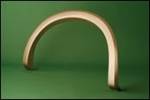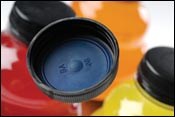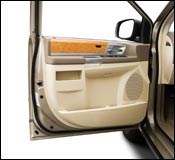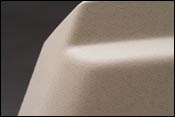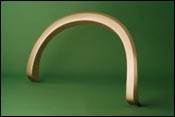Clear Road Ahead for TPOs, TPVs
Olefinic TPEs originally comprised only two classes of rubber-modified polypropylene, known as TPO and TPV. More recently, these have been supplemented by new types of olefinic elastomers that can be used on their own or as the rubber component in TPO/TPV compounds. Additionally, a small handful of specialty TPEs using olefinic matrices occupy niche applications.
The big story in olefinics is the growing presence of TPOs and TPVs in automotive interiors and exteriors, which account for about half of TPO/TPV use and even more of TPOs alone. Two major trends have been the domination of TPOs in bumper fascia (the largest volume use), and a continued thrust toward the all-olefinic auto interior.
In automotive, olefinic TPEs are replacing costlier and heavier TPUs, other TPEs, and PVC. The trend away from paint has produced new metallic-pigmented TPOs that are starting to appear on smaller exterior parts. Efforts continue to place TPOs in large exterior vertical panels, where “molded-in color” (MIC) is the preferred route.
Auto interiors have increasingly adopted unpainted TPO for soft-touch, low-gloss overmolding of consoles, pillars, door trim, shifter knobs, and brake handles. TPOs are being developed with excellent low-temperature impact resistance for airbag covers, and new TPVs are starting to encroach on sealing systems long dominated by thermoset EPDM.
Another active area of development is two-shot injection molding of larger parts such as TPV/TPO door panels, and instrument panels could be next. “The IP is the last major component that has yet to be heavily penetrated by PP-based materials,” says Marty Levine, global automotive marketing manager for ExxonMobil Specialty Elastomers.
TPOs and TPVs are also growing in non-automotive markets such as appliances, medical parts, packaging seals, wire/cable, and kitchen, power, and hand tools. Better overmold bonding to rigid plastics is a key trend, as is development of softer and more chemical- and heat-resistant grades. These include specialty niche products, such as novel clear TPOs, chlorinated olefins, and PIB TPVs.
These application trends have produced changes in basic composition of olefinic TPEs. A prominent example, says consultant Robert Eller, president of Robert Eller Associates, is the large-scale replacement of EPDM rubber in TPOs by metallocene-based ethylene-octene and ethylene-butene specialty elastomers, primarily Dow’s Engage and ExxonMobil’s Exact. Now, a newer generation of novel olefinic specialty elastomers—such as Dow’s Infuse OBCs and ExxonMobil’s Vistamaxx—are poised to introduce further evolution to TPOs and TPVs for automotive and other TPE markets.
In industrial and consumer applications, novel olefinic elastomers hold equal promise—and a challenge to traditional TPVs, TPOs, and styrenic TPEs like SEBS. Initial forays for these new materials have been in overmolded grips for tools and personal-care products, as well as seals, tubing, wire, and cable. Says Eller, “The battle for TPVs has been against SEBS with its higher heat resistance and better compression-set properties. Products like Dow’s Infuse OBC allow you to produce TPOs with flow, impact, and compression set that can compete with traditional TPVs and SEBS.”
A. Schulman’s North American automotive marketing manager, Jeff McCoy, says other new tools are emerging for making soft TPOs (under 50 Shore D). These include alloys and grafted TPE “hybrids” of olefinic and styrenic or other TPEs. As a result, he says, “The line between olefinic and styrenic TPEs is beginning to get blurred, as some styrenics have a strong olefinic component. I think future successes will come from such hybrid systems.” Schulman is in early development of soft TPOs made from hybrids (grafts or mixtures of different TPE chemistries) that could improve scratch and mar resistance, weatherability, and clarity in order to replace TPU and PVC auto interior calendered films and soft-touch grips.
Louis Cirihal, global product development manager for Dow’s Infuse OBC family, also sees a likely trend toward use of hybrid combinations of TPEs to replace existing rubber systems in TPOs.
New TPOs are also expanding opportunities for thermoformable sheet in truck rockers, bumpers and cab interior parts, as well as marine and other applications. Eller says materials evolution has accompanied processing improvements that make thermoforming economical for larger production runs than before—80,000 to 100,000 vehicles.
NEW SPECIALTIES WEIGH IN
Innovative compounders are formulating TPOs and TPVs with novel olefinic specialty elastomers that have emerged over the last few years. Among these are ExxonMobil’s Vistamaxx and Dow’s Versify families of propylene-ethylene elastomers and Dow’s Infuse Olefinic Block Copolymers (OBCs), with their unique block structure of linear MDPE crystalline hard blocks and Engage-type ethylene-octene amorphous soft segments. Each is said to have a broad spectrum of potential uses, from flexible molded goods to extruded hoses, tubes, films, and fibers, as well as creation of new compounded TPOs or TPVs.
Dow’s first target for Infuse OBCs are TPOs with up to 90 A hardness. Problems with softer traditional TPOs have included low heat resistance, low melt strength, and slow processing. Infuse OBCs’ higher crystallization temperature enables production of soft TPOs with a higher service temperature, better extrudability, and faster processing.
The first soft TPOs and TPVs made with Infuse OBC are appearing in consumer products such as housewares, soft-touch grips, wine corks, and bottle-cap liners. Potential automotive applications include floormats and overmolded soft-touch parts to replace TPUs or conventional TPVs. Adds Cirihal, “We also see potential for Infuse OBCs to expand the properties and applications of TPVs. Compounders could make Infuse OBC/TPV blends, but it would be even more interesting to produce an Infuse OBC-based TPV.” In general, however, Cirihal sees “a much larger opportunity for their use in soft TPOs than in TPVs.”
Dow is also exploring foams for sports, leisure, and consumer products, where Infuse OBCs reportedly can provide much lower shrinkage and compression set. By replacing the EPDM component, Infuse OBCs can produce compounds with improved colorability, surface finish, and aesthetics, according to Cirihal. Compounders who have licenses to use Infuse in TPEs include GLS Corp., (now wholly owned by PolyOne), Teknor Apex, and CTS in France.
Joe Kutka, GLS technology launch manager, says his firm’s new Dynalloy OBC injection and blow molding TPOs are aimed initially at overmolded grips in personal-care items, tools, and armrests. “These compounds provide unique visual aesthetics because of their better flow properties. They also bond well to PP, have no adverse effect on cycle times—especially for thin-wall applications, and a non-tacky feel. Also, because they are translucent they permit a better color palette, which has been a limitation of traditional TPVs.”
Teknor Apex just launched the Telcar OBC family of TPOs for consumer and industrial injection molding, blow molding, and extrusion. Opaque and translucent compounds are aimed at food and beverage packaging, office products, medical devices, cosmetic and personal-care products, hoses, tubes, gaskets, seals, weather stripping, and wire/cable. “OBC technology yields elastomers that bridge the previous cost-performance gaps and enables us to provide customers with a true alternative to styrenic TPEs,” says Sanjin Sakhalkar, new business development manager. OBC compounds boast superior compression set, heat aging, chemical resistance, and processability, as well as equivalent or greater tear and tensile strength and improved aesthetics. They readily extrude into thin sheet and tubing, he says, and are so strong and elastic that they can be drawn down into very thin film without tearing. Initially available in 30 to 75 Shore A, they will eventually be offered in a much broader range of Shore A hardnesses, from the single digits to 90 and above.
ExxonMobil’s Levine says both its Exact plastomers and new Vistamaxx are being used internally and by independent compounders to make improved soft TPOs for automotive and non-automotive applications. “Vistamaxx’s excellent transparency and colorability lend itself to clear and MIC TPOs. They are also being used to produce several TPVs.”
Without identifying it specifically, Elastocon TPE Technologies says it used a “brand-new elastomeric polymer” in the category of those mentioned above to formulated its new Elastocon SMR Series of TPOs in six standard grades from 40 to 65 D. Says company president Dave Barkus, “We were able to tweak the formulations to have all the three properties that are hard to leverage: high gloss, scratch-and-mar resistance, plus cold-temperature impact down to -30 F.” These engineering-grade TPOs are intended to replace more costly materials like ionomer-based compounds in body panels, fenders, and bumper fascia for cars, RVs, and industrial and utility vehicles. They also have potential for center consoles and living-hinge parts requiring very strong materials with very high flow and high gloss.
AUTO INTERIORS
Trends in the high-growth auto-interior sector include MIC soft-touch TPO trim, two-shot TPV or TPO overmolding of larger parts, TPO air-bag covers, and TPV body and blazing seals. Doug Mosier, NAFTA automotive business manager at LyondellBasell, sees many opportunities for TPOs to replace other plastics in interiors. One of his firm’s newest offerings for interior low-gloss, soft-touch parts is the Softell TPO family. Produced with the Catalloy process, they enable the manufacture of a finished product without the need for a “second surface” or skin and with 40% estimated cost savings over SEBS, TPU, PVC, and painted PP.
Applications include door panels, center consoles, instrument panels, luggage covers, pillar trim, glove boxes, and soft inlays, where they can replace TPVs, PUR spray skins, and PVC or TPU slush-molded skins. “Softell will allow for broader acceptance of an all-TPO instrument panel, as there is no skin required. Softell molded parts allow you to achieve soft touch and low gloss when before you needed paint. Although other low-gloss and scratch- and mar-resistant TPOs exist, people still find the need for a skin and or painted soft surface.”
Meanwhile, the news in two-shot automotive injection molding is larger parts such as door panels. Eller cites the example of the Dodge Caliber interior door panel/medallion, which consists of a slightly foamed TPV over a rigid PP substrate. He sees important cost savings in being able to make a soft-skinned I.P. in one step and one machine. “Thermoformed skins have advantages in aesthetics and cushioning, but they are costly because they use different processes to make parts of the I.P.”
A. Schulman is pursuing this approach with its new Invision Enhanced Processability (EP) series of TPVs for soft-touch interior trim. These TPV compounds have better oil resistance and less fogging, according to McCoy. The first grade, Invision VX 50 85 UI EP, is a very high-flow, 85 A TPV, which was used for the door panels of several 2008 Dodge, Chrysler, and Jeep platforms. It is made by two-shot overmolding a 2-mm TPV skin over a TPO substrate. McCoy says Schulman is working on very high-flow grades that do not require predrying and is looking to include a third layer of an olefinic foam for improved compression softness.
Dave Mitchell, global market manager of Dow Elastomers, says the company is evaluating two- and three-shot injection molding of skin-foam-substrate structures with TPOs. He says I.P.s are “on the industry’s radar” for this process, but the key to commercial viability is cost-performance. In particular, better grain retention in the molded skin, better feel, and improved part uniformity are essential. “Today, such a huge conversion from a multi-component to one component system would require designers to sacrifice aesthetics and haptics (feel), which they are not willing to give up. So continued development of polymers and processes is imperative,” he adds.
Meanwhile, TPOs have been making a big dent in PVC and higher-priced TPEs in airbag covers and interior pillars. One reason is better airbag deployment by TPOs at -40 C. Moreover, as airbags continue to proliferate in the interior compartment (e.g., side curtain, side impact), more and more parts are in their deployment paths and thus require ductile impact failure, notes LyondellBasell’s Mosier.
He says new grades in the company’s Sequel 2200 and Hifax families have expanded the use of TPOs in A, B, and C pillar covers that are in the path of airbag deployment and must withstand low-temperature impact. One example is Sequel 2326 BDX compounded TPO in the roof pillar of the 2008 Jeep Grand Cherokee. Its MIC multi-fleck, fabric-textured surface is a sign of the trend toward “soft-look,” fabric-like appearance in such parts.
AUTOMOTIVE SEALING
In less than five years, TPVs have made significant inroads in automotive weather-seals to replace thermoset EPDM, which still accounts for about 80% of sealing, according to Jonas Angus, founder and president of TPE Solutions. “DaimlerChrysler is taking a major lead” in TPV weatherseals, Angus says, “and GM and Ford are following. Cost is the biggest advantage, with TPVs 10% to 30% lower than EPDM, along with lower weight, improved design flexibility, and recyclability.”
Lynell Maenza, industry segment manager at ExxonMobil Specialty Elastomers, says that firm developed special TPV weatherseal products, such as Santoprene B200 for exterior corner moldings. It reportedly bonds well without adhesives to sealing profiles of EPDM or other TPVs. Good TPV-to-EPDM bonding reportedly has been lacking in past corner-seal products. B200 also offers the low CLTE required for long sealing parts, says Maenza.
Two SPE Automotive Innovation Awards were given in 2007 for TPV sealing products. One was the robotic extrusion and bonding of a Santoprene TPV E500 surround seal directly on the door-module carrier for the 2007 Dodge Nitro and 2008 Jeep Liberty SUVs. Another was the first TPV glass-run seal for a sliding door, used on the 2008 Chrysler minivan. Two coextruded TPV profiles were inserted into an injection tool and overmolded with TPV corner moldings. The three-layer coextrusions contained hard and soft Sarlink TPVs from DSM Thermoplastic Elastomers. The profile top layer and corner moldings are TPVs created by the molder, Jyco Sealing Technologies of Dexter, Mich.
A. Schulman is working on exterior seals with coextrusions of its Invision TX fully cured TPVs and styrenic TPEs in matched body color. The first use will be on a 2010 GM vehicle.
Ferro Corp.’s Engineered Polymer Products unit aims its Alcryn MPR at automotive window lace and sealing applications. Alcryn is an ethylene-based, partially crosslinked, chlorinated polyolefin.
EXTERIOR AUTOMOTIVE
Opportunities for TPOs in exteriors involve three challenges: reducing assembly complexity, meeting the requirements of vertical panels, and eliminating paint. New TPOs in recent years achieve a better balance of high impact and high stiffness as well as low CLTE, which allows the use of fewer brackets for larger parts such as bumpers, explains LyondellBasell’s Mosier. “Whereas traditional TPO bumpers had a flexural modulus of 700 to 900 MPa, OEM’s are now specifying newer TPOs with 1500 to 2000 MPa. The result is reduced cycle time, more design freedom and lighter weight.”
Vertical panels have been molded successfully of TPO in Europe using fine-particle talc fillers. For example, the new BMW X5 features the first all-plastic single-module fender, Molded of Daplen EF341AE 30% talc-filled TPO from Borealis. This is described as the most highly integrated body application to date. Another example is the Smart fortwo, the first commercial vehicle with all-TPO body panels. Borealis’ Daplen ED230HP, a 20% talc-filled TPO with a low density of 1.05 g/cc replaces PC/PBT in the injection molded hood, front, rear, and side panels, reducing the overall car weight by 15% (See Learn More).
Says LyondellBasell’s Mosier, “We are seeing some success in North America, but generally in smaller parts. Vertical panels have been a slower road for TPOs since many are painted in a process that does not support plastic parts, and there are also some limitations in material properties.”
Dow’s Mitchell says the challenges to be met are primarily reducing the CLTE of plastic body panels. “When you are able to limit or negate the CLTE of plastics or bring it close to that of aluminum or steel, that’s when plastics will make it in various types of exterior panels.”
Meanwhile, Tier 1 suppliers in North America are moving away from paint and into precolored TPOs. “The surface aesthetics of precolored compounds call for better quality control,” says Teknor Apex’s Sakhalkar. “Most of the success in exteriors has been in smaller parts due to the need for higher weatherability and high gloss.”
According to Dow’s Mitchell, “With MIC, you typically lose depth of color. In painting TPO, you need a primer, paint, and clear coat. The effort is to get away from at least the primer, so we are exploring how to produce TPOs that will not need it.”
The Indure family of scratch- and mar-resistant MIC metallic-pigmented TPOs from LyondellBasell have appeared in several recent exterior parts. One is the wheel flare on Ford’s 2008 F-250 Super Duty pickup truck. This Class-A part is made of Indure X-76, a 35-MFR TPO that replaced painted TPO (see Learn More). Newer applications for the Indure MIC family include the grille surround of the 2008 Pontiac Torrent and the skid plate of front and rear bumper fascia on the Suzuki XL7, where Class-A TPO is replacing clear-coated aluminum.
Says Mosier, “We see a lot if interest from OEMs for the entire Indure MIC family of TPOs, designed for high or low gloss, grained or ungrained, exterior and interior parts. We can match about 75% of existing paint colors.” Still, he concedes that any high-gloss Class-A metallic paint system can shift in appearance (metamerism) with changes in viewing angle and lighting conditions. Right now, those effects are hard to match with MIC plastics.
NON-AUTOMOTIVE TRENDS
Industrial and consumer soft-touch applications are ripe for continued penetration by TPOs and TPVs in tools, personal-care products, and building/construction seals. Robert Eller sees growth in flexible TPO flat roofing. Overmold bondability is a key property in many applications.
Soft TPOs based on ExxonMobil’s Vistamaxx are said to offer good grip and excellent bonding to PP for products such as razors, sports equipment, and pen grips. They are aimed at displacing SEBS. Dow’s Mitchell says most of that firm’s non-automotive TPOs go into molded storage bins, personal-care, and medical applications. These include replacing TPU or SEBS in soft-touch handles.
ExxonMobil has expanded its portfolio of Santoprene TPVs for use as bonding materials to 30, 12 of which were commercialized in the last 12 months. One of the newest is Santorprene B500, said to be the first TPV to bond to nylon in cold-insert ovemolding. Because heat is typically necessary for bonding, TPV/nylon overmolding has required a two-shot process with special machines and expensive tooling. Ability to overmold in a second machine and tool makes soft-touch overmolding more practical for smaller-volume applications that cannot justify two-shot tool cost.
What’s more, B500 grades can achieve a good bond with overmold layers as thin as 0.5 mm, while previous grades can require at least 1.5 mm, Maenza says. Applications include soft-touch grips on kitchen and power tools and seals and gaskets for mobile phones and appliances such as dishwashers.
ExxonMobil also has a new family of fast-cycling TPVs to replace rubber and other TPEs in thick-wall (over 2 mm) parts. Santoprene TPV M500 reduces processing time by 20% to 30% in components such as plugs, bumpers, grommets, gap fillers, spacers, and motor mounts.
DSM’s Greenberg sees potential for softer TPVs in not-yet-penetrated applications where they can replace rubber compounds and more costly TPEs. Whereas most TPVs have ranged from 55 A to 50 D, DSM now has Sarlink grades as soft as 20 A.
A new class of olefinic TPVs is available from Kaneka Texas. David Marshal, director of new business development, says the new Sibstar TPVs are silane-crosslinked polyisobutylene (PIB) in PP or HDPE matrices. Supplied as masterbatches with high PIB rubber loading, they offer good barrier to gases and moisture and have lower compression set at elevated temperatures than Sibstar SIBS TPEs. They are aimed at barrier closure systems, such as cap seals for food-related products where extended shelf life is sought, as well as engineered hoses for food-processing equipment or refrigerators.
A novel transparent TPO developed by Mitsui Chemicals can be used in flexible tubing, lenses, and films. It also can modify PP to add toughness and eliminate stress whitening while maintaining clarity. Mitsui’s Notio TPO boasts a unique nanocrystalline structure: Whereas typical TPO shows fairly large crystalline domains with an amorphous matrix, Notio shows no visible domains at similar magnification in an electron microscope. Instead, Notio has a thread-like 3D network of crystalline segments throughout the amorphous matrix. Mitsui cites a combination of good transparency, elasticity, and heat resistance, as well as softness and very low density—around 0.867 g/cc (See Learn More.)
ExxonMobil and Ferro’s EPP unit are aiming Santoprene and Alcryn MPR at replacing PVC or crosslinked PE in wire and cable. Targets are both general jacketing and high-end cable applications.
Meanwhile, a novel class of TPV retains PP as the matrix but has a styrenic elastomer as the rubber. Teknor Apex substitutes a hydrogenated styrenic block SBC for EPDM in its Uniprene XL, which boasts superior long-term elastic recovery, improved resistance to hot oils and solvents, and greater tensile strength than conventional TPVs. Teknor Apex aims to raise the heat resistance from 125 C to 150 C.
THERMOFORMABLE TPO SHEET
Dow’s Inspire family of high-melt-strength TPOs are said to provide a wider processing window for large-part thermoforming, such as RV components. These materials typically use Engage 7387 and 7487 elastomers, which boost the typical 3:1 draw ratio up to 9:1 while holding uniform wall thickness.
New thermoformable TPO sheet products include the Exultra multilayer sheets from Premier Material Concepts (PMC), offered as a cost-effective, recyclable alternative to vinyl-wrapped ABS for marine interior panels and consoles, office furniture, seating, and exercise equipment. It can also replace of PVC and thermoset FRP composites in all-terain vehicles, RVs, and trucks. PMC offers a three-layer combination of a weatherable TPO cap, olefinic elastomer foam middle layer, and a high-impact TPO core. A two-layer version has a weatherable TPO cap laminated on a high-impact TPO. Both are claimed to have better toughness than ABS and moisture, scratch, and mar resistance.
Also new is a thermoformable TPO sheet from Spartech that is said to offer improved processability for RV, bus, truck, and marine applications. “Extreme” sheet products comprise three grades that provide a wider processing window, better sag control, and enhanced aesthetics. Aimed at replacing FRP, they range from low/medium to high gloss, and one version is laminated with Spartech’s Korad acrylic film, which imparts gloss plus abrasion and chemical resistance, eliminating the need for paint or other coatings. Among the first applications are 8 x 10 ft RV exterior panels. Other potential opportunities include ABS replacement in tractor fenders, vertical panels and roofs, and kayaks.
Related Content
Fundamentals of Polyethylene – Part 5: Metallocenes
How the development of new catalysts—notably metallocenes—paved the way for the development of material grades never before possible.
Read MorePolyethylene Fundamentals – Part 4: Failed HDPE Case Study
Injection molders of small fuel tanks learned the hard way that a very small difference in density — 0.6% — could make a large difference in PE stress-crack resistance.
Read MoreDelivering Increased Benefits to Greenhouse Films
Baystar's Borstar technology is helping customers deliver better, more reliable production methods to greenhouse agriculture.
Read MoreFundamentals of Polyethylene – Part 6: PE Performance
Don’t assume you know everything there is to know about PE because it’s been around so long. Here is yet another example of how the performance of PE is influenced by molecular weight and density.
Read MoreRead Next
Metallic-Pigmented TPO Debuts in Auto Exterior Trim
A molded-in-color, high-gloss, metallic-pigmented TPO wheel flare is making its commercial appearance next month with the launch of the 2008 F-250 Super Duty pick-up truck from the Ford Motor Co.
Read MoreSee Recyclers Close the Loop on Trade Show Production Scrap at NPE2024
A collaboration between show organizer PLASTICS, recycler CPR and size reduction experts WEIMA and Conair recovered and recycled all production scrap at NPE2024.
Read More

